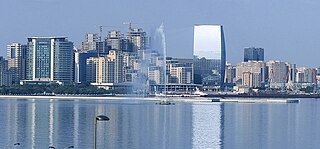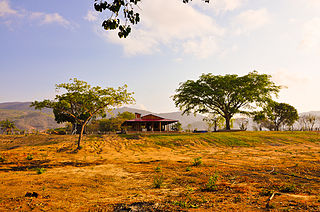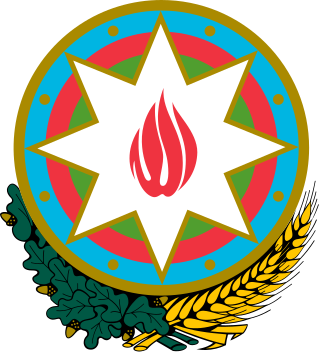Related Research Articles

The economy of Azerbaijan has completed its post-Soviet transition into a major oil-based economy, from one where the state played the major role. The transition to oil production led to remarkable growth figures as projects came online; reaching 26.4% in 2005 and 34.6% in 2006 before subsiding to 10.8% and 9.3% in 2008 and 2009 respectively. The real GDP growth rate for 2011 was expected at 3.7% but had dropped to 0.1%. Large oil reserves are a major contributor to Azerbaijan's economy. The national currency, the Azerbaijani manat, was stable in 2000, depreciating 3.8% against the dollar. The budget deficit equaled 1.3% of GDP in 2000.

The economy of Georgia is an emerging free market economy. Its gross domestic product fell sharply following the dissolution of the Soviet Union but recovered in the mid-2000s, growing in double digits thanks to the economic and democratic reforms brought by the peaceful Rose Revolution. Georgia continued its economic progress since, "moving from a near-failed state in 2003 to a relatively well-functioning market economy in 2014". In 2007, the World Bank named Georgia the World's number one economic reformer, and has consistently ranked the country at the top of its ease of doing business index.

Heydar Alirza oghlu Aliyev was an Azerbaijani politician who served as the third president of Azerbaijan from October 1993 to October 2003. Originally a high-ranking official in the KGB of the Azerbaijan SSR, serving for 28 years in Soviet state security organs (1941–1969), he led Soviet Azerbaijan from 1969 to 1982 and held the post of First Deputy Premier of the Soviet Union from 1982 to 1987.

An ejido is an area of communal land used for agriculture in which community members have usufruct rights rather than ownership rights to land, which in Mexico is held by the Mexican state. People awarded ejidos in the modern era farm them individually in parcels and collectively maintain communal holdings with government oversight. Although the system of ejidos was based on an understanding of the preconquest Aztec calpulli and the medieval Spanish ejido, since the 20th century ejidos have been managed and controlled by the government.
Mission Zamora is an integrated land reform and land redistribution program in Venezuela, created in law by the Ley de Tierras, part of a package of 49 decrees made by Hugo Chávez in November 2001. The plan is named in honor of Ezequiel Zamora, a 19th-century Venezuelan peasant leader.

Before the 1910 Mexican Revolution, most land in post-independence Mexico was owned by wealthy Mexicans and foreigners, with small holders and indigenous communities possessing little productive land. During the colonial era, the Spanish crown protected holdings of indigenous communities that were mostly engaged in subsistence agriculture to countervail the encomienda and repartimiento systems. In the 19th century, Mexican elites consolidated large landed estates (haciendas) in many parts of the country while small holders, many of whom were mixed-race mestizos, engaged with the commercial economy.
The primary crops produced in Azerbaijan are agricultural cash crops, grapes, cotton, tobacco, citrus fruits, and vegetables. The first three crops account for over half of all production, and the last two together account for an additional 30 percent. Livestock, dairy products, and wine and liquors are also important farm products.
The Comprehensive Agrarian Reform Program, more commonly known as CARP, is an agrarian reform law of the Philippines whose legal basis is the Republic Act No. 6657, otherwise known as the Comprehensive Agrarian Reform Law (CARL). It is the redistribution of private and public agricultural lands to help the beneficiaries survive as small independent farmers, regardless of the “tenurial” arrangement. Its goals are to provide landowners equality in terms of income and opportunities, empower land owner beneficiaries to have equitable land ownership, enhance agricultural production and productivity, provide employment to more agricultural workers, and put an end to conflicts regarding land ownership.
Banking in Azerbaijan in its present form dates back to 1992, but it originates in the second half of the 19th century and continued through the Soviet period. It consists of the country's central bank, the Central Bank of Azerbaijan, founded on 11 February 1992, and other commercial banks. The commercial banks in the country are joint–stock. The only valid currency in Azerbaijan is the Azerbaijani manat. Only the Central Bank can issue manats. During the transition to a market economy in the 1990s, the banking system was not meeting the needs of socioeconomic development as expected, and followed old, Soviet laws. Banks in Azerbaijan have mandatory reserves, determination of norms, regulations of liabilities between creditors and depositors, and deposit insurance. These laws were introduced in 1996 after the system proved to violate laws and timely repayments of deposits. The country's banking system is now stable.
The tax legislation of Azerbaijan is comprised by the Constitution of Azerbaijan Republic, the Tax Code and legal standards which are adopted herewith. The taxes levied in Azerbaijan can be generally broken down into 3 main types: state taxes, taxes of autonomy republic and local (municipal) taxes. State taxes include the following: personal income tax, corporate tax, value added tax, excise tax, property tax, land tax, road tax, mineral royalty tax and simplified tax. Taxes of autonomy republic are the same as state taxes but levied in Nakhichevan Autonomous Republic.

The Ministry of Agriculture of Azerbaijan is an Azerbaijani governmental agency within the Cabinet of Azerbaijan in charge of regulation of the economic activity in the agricultural sector of the country with a purpose of increasing the sector's production capacity. Agriculture is Azerbaijan's second most important natural resource playing a significant role in the country's economy. The ministry is headed by Inam Karimov.

The Ministry of Economy of Azerbaijan Republic is the central executive body responsible for implementing state policy and regulation in the following areas: formulating economic policy of Azerbaijan, producing macroeconomic projections, creating a favorable environment for economic development and growth, encouraging investment activity, developing entrepreneurship and industry, regulating the licensing and permit system, protecting, developing and encouraging competition, protecting the rights of consumers, implementing state procurement policy, ensuring full and timely introduction of taxes and other mandatory payments relating to the authority of the Ministry, in the state budget, management of government assets, privatization, establishing state land management system, conducting state registration and single state cadastre of immovable property.

The State Customs Committee of Azerbaijan Republic is a governmental agency within the Cabinet of Azerbaijan in charge of customs clearance for imports and exports, and regulation of all customs activities within Azerbaijan Republic. The committee is headed by Safar Mehdiyev.
Garib Mammadov Academician-secretary of Department of Agrarian Sciences of Azerbaijan National Academy of Sciences (2011). İs an Azerbaijani scholar and politician serving as the Chairman of State Land and Cartography Committee of Azerbaijan Republic.
Agrarian reform and land reform have been a recurring theme of enormous consequence in world history. They are often highly political and have been achieved in many countries.
Land reform in the Philippines has long been a contentious issue rooted in the Philippines's Spanish Colonial Period. Some efforts began during the American Colonial Period with renewed efforts during the Commonwealth, following independence, during Martial Law and especially following the People Power Revolution in 1986. The current law, the Comprehensive Agrarian Reform Program, was passed following the revolution and extended until 2014.
The Finance system in Azerbaijan consists of government policy and arrangements for borrowing and lending and the transfer of assets. The system is composed of banks, insurance companies, other financial institutions, pension system, financial markets and payment systems.
The Latvian Land Reform of 1920 was a land reform act expropriating land under the Republic of Latvia in 1920. The agrarian reform law of 1920 sought to transfer most of the land from Baltic German nobles to Latvian farmers. On September 16, 1920 Constitutional Assembly of Latvia passed the law of the Land reform, which would break up large landholdings and redistribute land to those peasants who worked it and to the newly created Latvian State Land Fund. Similar land reforms were carried out in Estonia (1919), Lithuania and Poland.
This is a list of events that took place in the year 1995 in Azerbaijan.
Since their independence in 1991 from the Soviet Union, and suffering through a civil war that lasted from 1992 to 1997, Tajikistan has had a difficult time recovering economically and structurally. This economic strain has affected the family dynamic. It is now common for the men to work abroad in Russia, leaving the women to manage the land and children. Up to 74% of the population live in rural areas and rely heavily on agriculture. These women take on the duties of their husbands and or family members, along with their responsibilities as caretakersf. In some cases the men do not return to their homes and or ask for a divorce, leaving their wife and children in a vulnerable position. Tajikistan's culture is deeply patriarchal, with women not attaining the same rights as men. Domestic violence has been a prevalent issue in Tajikistan. Lack of education, resources, cultural norms, and government enforcement, have been factors in women not reporting these crimes. Another issue is the landscape of Tajikistan: 93% of the region is mountainous. The poor infrastructure and isolated villages is a contribution in the difficulty of changing the ideas surrounding genders. The Tajikistan government, with help through partnerships with organizations like the United Nations and other Non Governmental Organizations have drafted several resolutions throughout the years to ameliorate these issues within their society. However, this issue still needs to be researched more deeply.
References
- 1 2 "Economic Diversification in Azerbaijan". China Institute of International Studies. Archived from the original on October 5, 2016. Retrieved April 11, 2018.
- ↑ Nadirov, Faig. "Azerbaijan Country Paper/ Land Policy Action Plan" (PDF). The United Nations Economic Commission for Europe. Archived (PDF) from the original on April 12, 2018. Retrieved April 11, 2018.
- 1 2 "Economic Reforms". Archived from the original on March 13, 2018. Retrieved April 11, 2018.
- ↑ "Land Reform and Farm Restructuring in Transition Countries: The Experience of Bulgaria, Moldova, Azerbaijan and Kazakhstan" (PDF). World Bank. Archived (PDF) from the original on October 11, 2020. Retrieved April 11, 2018.
- ↑ "Land Reforms". Archived from the original on September 5, 2017. Retrieved April 11, 2018.
- ↑ "Chronology of significant events on the eve of independence and after gaining the independence". Presidential Library: Independent Azerbaijan. Archived from the original on September 27, 2017. Retrieved April 11, 2018.
- ↑ "Azerbaijan: Prevailing systems of land tenure". Food and Agriculture Organization of the United States. Archived from the original on April 12, 2018. Retrieved April 11, 2018.
- 1 2 "Azerbaijan: Country Assessment on Land Acquisition and Resettlement" (PDF). Asian Development Bank. Archived (PDF) from the original on April 12, 2018. Retrieved April 11, 2018.
- ↑ "Law No.155-IG of 1996 on land reform". Food and Agriculture Organization of the United Nations. Archived from the original on April 12, 2018. Retrieved April 11, 2018.
- 1 2 3 4 5 "Spatial planning and land administration" (PDF). Archived (PDF) from the original on November 7, 2012. Retrieved April 11, 2018.
- ↑ "Law on soil fertility (1999)". Food and Agriculture Organization of the United Nations. Archived from the original on April 12, 2018. Retrieved April 11, 2018.
- ↑ "Law of the Azerbaijan Republic of July 16, 1996 No. 155-IQ". CIS Legislation. Archived from the original on April 12, 2018. Retrieved April 11, 2018.
- ↑ "Azerbaijan: Land Legislation". Food and Agriculture Organization of the United Nations. Archived from the original on April 12, 2018. Retrieved April 11, 2018.
- ↑ "The Tax Code of the Republic of Azerbaijan". Ministry of Taxes of the Republic of Azerbaijan. Archived from the original on August 12, 2014. Retrieved April 11, 2018.
- 1 2 3 "Legislative Sphere of Property Rights in Azerbaijan; Politico-legal Issues of Land Reform". Association of Land and Real Estate Professionals. Archived from the original on April 12, 2018. Retrieved April 11, 2018.